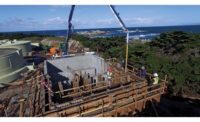The $13.5 billion in stimulus dollars for water projects announced in February could be just the start of a robust funding stream that will keep contractors busy in California for years to come.
More than $441 million in American Recovery and Reinvestment Act money will go to California wastewater and drinking water projects through the existing Environmental Protection Agency/California Water Board Clean Water and Drinking Water revolving fund grant programs. News of the influx of funding without the usual 20% match requirement brought a flood of projects to the state Water Board for consideration. Since the beginning of the year, $3.3 billion in projects have come forward in addition to the $1.9 billion originally in the pipeline.
State Water Board Supervising Engineer Christopher Stevens was optimistic that the stimulus was just the beginning of a return to federal funding of capital projects. “A renewed federal interest is resulting in increased levels of annual appropriations going forward,” Stevens said.
Danielle Blacet, a regulatory advocate at the Sacramento-based Association of California Water Agencies, likened the deluge of projects for consideration to a backed-up pipeline. “Some have been on the shelf since before the turn of the century, but couldn’t get started because there wasn’t any way to fund them,” Blacet said.
ARRA included some very specific distribution guidelines. Just over $280 million will go to California Wastewater projects. Half will be distributed as subsidies for disadvantaged communities and restarting projects that have been stalled by the state’s fiscal crisis. The other half will go to low- and no-interest loans.
Some projects could use a combination of loans and grants. For instance, a Linda County Water District Wastewater Treatment Plant expansion in Yuba County is on the state Water Resources Control Board potential projects list to receive $10 million in Disadvantaged Community subsidies and $48 million in loans. The agency has been on a priority list since 2006 when the California Regional Water Quality Control Board issued a cease-and-desist letter to the agency for discharging effluent to the Feather River.
The Water Quality Control Board estimates 20 million gal of raw sewage spills into California waterways each year through aging, inadequate infrastructure or when overloaded treatment plants shut down.
Other ARRA beneficiaries include $17 million for orphaned polluted underground storage petroleum tank sites and $4.6 billion nationally for Army Corps of Engineers environmental projects.
Like all stimulus projects, the dollars come with some strings. Contractors are testing the waters to see what level of domestic assembly fulfills the Buy America program requirements. Strict deadlines also require accelerated timelines.
Jeff Berk, senior vice president at Omaha, Nebr.-based HDR, Inc. said he has seen an influx of projects and a movement toward design/build contracts because they allow dirt to get turned before the entire design is finalized. He is also seeing a lot of interest from the construction community. “It is often standing room only at bidders meetings,” says Berk.



Post a comment to this article
Report Abusive Comment